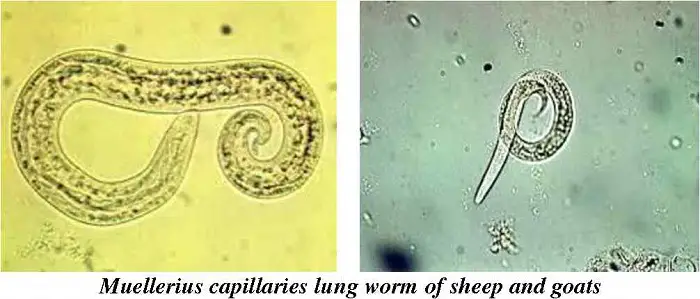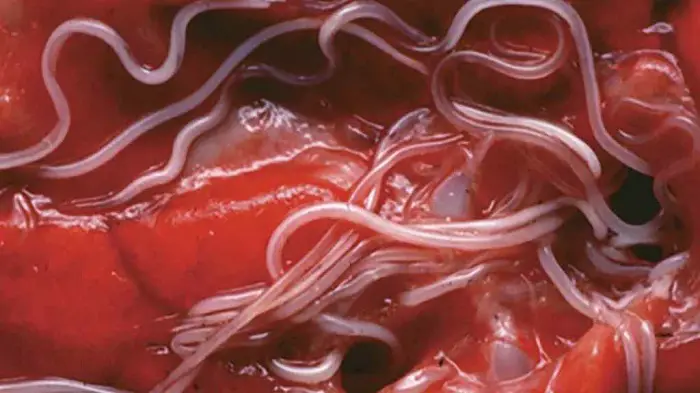Lungworm is a common parasite that affects sheep worldwide. The most common lungworm species affecting sheep are Dictyocaulus filaria and Muellerius capillaris. These parasites live in the lungs and airways of the sheep, causing inflammation, coughing, and respiratory distress.
Sheep become infected with lungworms by grazing on pastures contaminated with the larvae of the parasites. The larvae then migrate to the lungs and airways, where they mature into adult worms and begin laying eggs. The sheep cough up the eggs and then pass out in their feces, contaminating the pasture and perpetuating the infection cycle.
Causes of Lungworm in Sheep
Lungworm infection in sheep is caused by ingesting infective larvae of the parasites D filaria or M capillaris. These larvae are commonly found in contaminated pastures, and sheep become infected when grazing on the grass.
Lungworm larvae are generally found in pasture’s low-lying, wetter areas and are most commonly contracted by young lambs. However, adult sheep can also become infected if they graze in these areas or are exposed to contaminated pasture.
Once ingested, the lungworm larvae migrate through the digestive system and into the lungs, where they mature into adult worms. These worms then lay eggs, which are coughed up by the sheep and passed out in their feces, contaminating the pasture and perpetuating the cycle of infection.
Factors that can increase the risk of lungworm infection in sheep include grazing on contaminated pasture, overcrowding, poor nutrition, and stress. Implementing effective parasite control measures, such as regular deworming and rotational grazing, is essential to prevent lungworm infection in sheep.
Epidemiology of Parasitic Bronchitis in Sheep
Lungworm infection in sheep is a common problem worldwide, with varying degrees of prevalence depending on climate, geography, management practices, and animal health status.
In temperate climates, lungworm infections tend to be seasonal. The highest incidence occurs during the late summer and early autumn months when the larvae are most abundant in the pasture. In contrast, lungworm infections can occur year-round in tropical and subtropical regions due to the favorable climate conditions for the parasites.
Young sheep, particularly lambs, are more susceptible to lungworm infection than older animals, as their immune systems are still developing and they have had less exposure to the parasites.
In areas where lungworm is prevalent, it is common for a high proportion of sheep to be infected. However, the severity of the infection can vary depending on the number of parasites present, the age and health of the sheep, and other factors such as nutrition and stress.
Effective control measures, such as regular deworming and pasture management, can help to reduce the incidence of lungworm infection in sheep and minimize the economic losses associated with the disease.
Transmission of Lungworm in Sheep
Lungworm infection in sheep is transmitted through ingesting infective larvae, commonly found in contaminated pastures. The life cycle of lungworm involves several stages, which include the following:
- Adult worms live in the lungs and airways of infected sheep, where they lay eggs that are coughed up and then swallowed by the sheep.
- The eggs pass out of the sheep in their feces and develop into larvae in the pasture.
- The larvae are then ingested by grazing sheep and migrate through the digestive system and into the lungs, where they mature into adult worms.
Therefore, the primary mode of transmission of parasitic bronchitis is ingesting the infective larvae in the contaminated pasture. The risk of transmission is highest in areas where the parasites are prevalent and where pasture management practices are inadequate. Overcrowding and poor nutrition can also increase the risk of infection by weakening the sheep’s immune system and making them more susceptible to parasitic infections.
Clinical Signs of Parasitic Bronchitis in Sheep
Lungworm infection in sheep can cause a variety of clinical signs, ranging from mild to severe, depending on the severity of the infection. Some of the most common clinical signs of lungworm in sheep include:
- Coughing: A persistent cough is one of the most common clinical signs of parasitic bronchitis in sheep. This cough may be dry or moist and become more frequent as the infection progresses.
- Rapid and Shallow Breathing: Sheep with lungworm infection may exhibit rapid and shallow breathing, as the parasites can cause inflammation and damage the lungs and airways.
- Reduced Appetite and Weight Loss: Infected sheep may show a reduced appetite and may lose weight due to the stress of the infection and the damage to their respiratory system.
- Lack of Energy: Lungworm infection can cause sheep to become lazy and less active.
- Respiratory Distress: In severe cases, lungworm infection can cause respiratory distress, with sheep exhibiting labored breathing and gasping for air.
- Nasal Discharge: Infected sheep may also have a clear or mucopurulent nasal discharge, indicating inflammation and irritation in the respiratory tract.
- Anemia: In some cases, lungworm infection can cause anemia, manifesting as pale gums, eyelids, or the inside of the ears.
If any of these signs are observed, it is essential to consult a veterinarian for an accurate diagnosis and appropriate treatment. Prompt treatment can help reduce the infection’s severity and prevent complications.
Diagnosis of Lungworm in Sheep
Diagnosis of lungworm infection in sheep typically involves a combination of clinical examination, laboratory analysis, and assessment of the sheep’s management history. Some of the diagnostic methods commonly used for lungworm infection in sheep include:
- Clinical Signs: Clinical signs such as coughing, rapid and shallow breathing, reduced appetite and weight loss, lack of energy, respiratory distress, and nasal discharge may suggest lungworm infection in sheep.
- Fecal Examination: Lungworm eggs can be detected in fecal samples using a fecal flotation test, which involves mixing a small number of feces with a flotation solution and examining the sample under a microscope.
- Serology: Blood samples can be analyzed to detect the presence of antibodies to lungworm parasites.
- Postmortem Examination: In some cases, lungworm infection may be diagnosed through postmortem examination of the lungs and airways.
It is essential to consult a veterinarian for an accurate diagnosis, as the clinical signs of lungworm infection can be similar to those of other respiratory diseases. Additionally, proper management and treatment plans can be formulated based on a confirmed diagnosis of lungworm infection in sheep.
Differential Diagnosis Parasitic Bronchitis in Sheep
The clinical signs of lungworm infection in sheep can be similar to those of other respiratory diseases, so it is essential to consider a range of differential diagnoses when evaluating a sheep with respiratory symptoms. Some of the differential diagnoses that should be considered include the following:
- Bacterial Pneumonia: Bacterial pneumonia is a common respiratory disease in sheep and can cause similar clinical signs to lungworm infection.
- Viral Infections: Several viral infections, such as the ovine respiratory syncytial virus (ORSV), adenovirus, and parainfluenza virus, can cause respiratory symptoms in sheep.
- Parasitic Infections: Other parasitic infections, such as nasal bots and lung fluke, can cause respiratory symptoms in sheep.
- Allergic Reactions: Allergic reactions to environmental factors such as dust, pollen, or mold can also cause respiratory symptoms in sheep.
- Lung Cancer: While rare in sheep, lung cancer can cause respiratory symptoms and should be considered a possible differential diagnosis.
- Heart Failure: Heart failure can cause respiratory distress and should be considered a possible cause of respiratory symptoms in sheep, especially if there is a history of heart disease or other cardiovascular problems.
A proper diagnosis of lungworm infection in sheep requires a thorough evaluation of the animal’s clinical history, clinical signs, laboratory results, and a differential diagnosis to rule out other possible causes of respiratory symptoms.
Treatment of Lungworm in Sheep
The treatment of lungworm infection in sheep typically involves the use of anthelmintic drugs, which are medications that are specifically designed to kill parasitic worms. Several anthelmintic drugs are available for treating lungworm infection in sheep, including benzimidazoles, macrocyclic lactones, and imidazothiazoles.
The specific drug and dosage used for treatment may vary depending on the infection’s severity and the sheep’s age and weight. Multiple treatments are sometimes necessary to eliminate the parasites.
In addition to drug therapy, supportive care may be necessary for sheep with severe respiratory symptoms or complications, such as oxygen therapy or antibiotics to treat secondary bacterial infections.
It is also essential to implement management practices to prevent reinfection and the spread of infection to other sheep, such as pasture management and quarantine of infected animals.
It is essential to consult with a veterinarian for an accurate diagnosis and appropriate treatment plan, as using anthelmintic drugs requires a proper understanding of the medication and dosage requirements. Additionally, it is essential to follow proper withdrawal periods for meat and milk, as some anthelmintics have restrictions on their use in lactating and pregnant animals.
Prevention and Control of Parasitic Bronchitis in Sheep
Prevention and control of lungworm infection in sheep involve a combination of management practices and targeted use of anthelmintic drugs. Some strategies that can be used to prevent and control lungworm infection in sheep include:
- Pasture Management: Lungworm larvae are commonly found in contaminated pastures, so good pasture management practices can help reduce the risk of infection. This includes rotating pastures, avoiding overstocking, and removing manure from pastures to prevent larval buildup.
- Grazing Management: Sheep should be grazed on clean pasture and should not be allowed to graze in areas heavily contaminated with lungworm larvae.
- Targeted use of Anthelmintics: Regular treatment with anthelmintic drugs can help control lungworm infection in sheep. However, it is important to avoid the overuse of these medications, as this can contribute to the development of drug-resistant parasites.
- Quarantine and Testing: New sheep should be quarantined and tested for lungworm infection before being introduced to the rest of the flock to prevent the spread of infection.
- Vaccination: A lungworm vaccine is available for sheep in some countries, which can help reduce the risk of infection.
- Monitoring and Surveillance: Regular monitoring and surveillance of the flock for clinical signs of lungworm infection can help identify and control outbreaks early.
- Good Husbandry Practices: Providing good nutrition, clean water, and adequate shelter can help keep sheep healthy and reduce the risk of infection.
Concluding Remarks on Lungworm in Sheep
Lungworm infection is a significant concern for sheep farmers, as it can cause significant health issues and economic losses in affected flocks. Early recognition, diagnosis, and treatment are essential to minimize the impact of lungworm infection on sheep health and productivity.
Prevention and control strategies, such as pasture management, targeted use of anthelmintics, and good husbandry practices, can help reduce the risk of infection and limit the spread of the parasite in the flock. Sheep farmers must work closely with their veterinarians to develop a comprehensive prevention and control program tailored to their flock’s needs.

